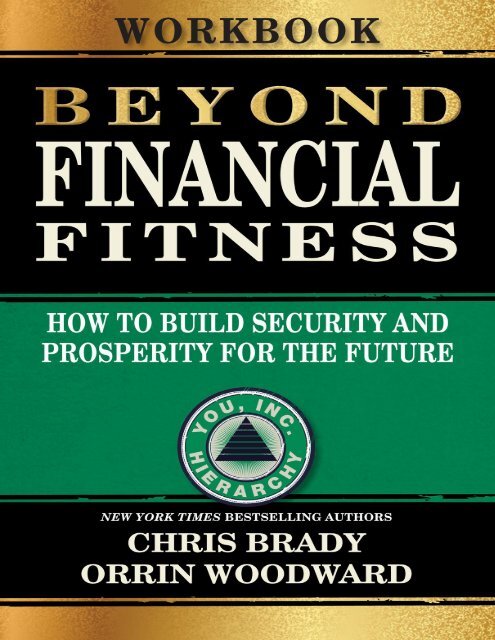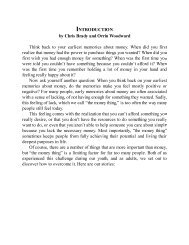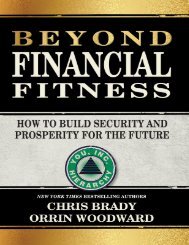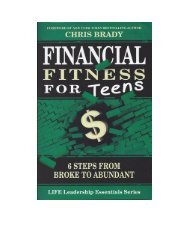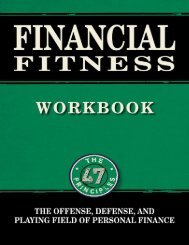Beyond Financial Fitness Workbook
You also want an ePaper? Increase the reach of your titles
YUMPU automatically turns print PDFs into web optimized ePapers that Google loves.
The information presented in this book is for general educational purposes only, and<br />
provides information the authors believe to be accurate on the subject matter covered. It is<br />
sold with the understanding that neither the authors nor the publisher are providing advice<br />
for any particular portfolio or for any individual’s particular situation, or rendering<br />
investment advice or other professional services such as legal or accounting advice. If<br />
expert assistance in areas that include investment, legal, and accounting advice are needed,<br />
please seek a competent professional’s services.<br />
This publication may make reference to performance data collected over various periods of<br />
time. Remember that past results do not guarantee future performance. Performance data,<br />
as well as laws and regulations, change over time, which could affect the applicability of the<br />
information presented in this book. Any data presented herein is used merely to illustrate<br />
the underlying principles.<br />
This book is not to serve as the basis for any financial decision or as a recommendation of<br />
any specific investment.<br />
No warranty is made with respect to the accuracy or completeness of the information<br />
contained herein, and both the authors and the publisher specifically disclaim any<br />
responsibility for any liability, loss, or risk, personal or otherwise, which is incurred as a<br />
consequence, directly or indirectly, of the use and application of any of the contents of this<br />
book.<br />
Copyright © 2016 by Life Leadership<br />
All rights reserved. No part of this book may be reproduced or transmitted in<br />
any form or by any means, electronic or mechanical, including photocopying<br />
and recording, or by any information storage and retrieval system, without the<br />
written permission of Obstaclés Press. Inquiries should be sent to the<br />
publisher.<br />
Obstaclés Press and the Obstaclés logo are trademarks of LIFE Leadership.<br />
Published by:<br />
Obstaclés Press<br />
200 Commonwealth Court<br />
Cary, NC 27511<br />
financialfitnessinfo.com<br />
ISBN: 978-0-9976311-5-9
First Edition, July 2016<br />
10 9 8 7 6 5 4 3 2 1<br />
Book design by Norm Williams, nwa-inc.com<br />
Printed in the United States of America
CONTENTS<br />
Introduction<br />
Part I—Comprehensive <strong>Financial</strong> Plan<br />
CHAPTER ONE: Having the Right Idea about Money<br />
CHAPTER TWO: Directing the Cash Flow<br />
CHAPTER THREE: Building Your<br />
<strong>Financial</strong> Life—A Complete Picture<br />
Part II—Investment Policy<br />
CHAPTER FOUR: The Top of the Hierarchy<br />
CHAPTER FIVE: Risk Factors Working Against You<br />
Part III—Asset Allocation Plan<br />
CHAPTER SIX: Assets Explained–<br />
Part I: The Left Side of the Risk Meter<br />
CHAPTER SEVEN: Assets Explained–<br />
Part II: The Right Side of the Risk Meter<br />
CHAPTER EIGHT: Diversification and Asset Allocation<br />
CHAPTER NINE: Putting It All Together<br />
CHAPTER TEN: The Future
INTRODUCTION<br />
“It is easy in the world to live after the world’s opinion; it is easy in solitude<br />
to live after our own; but the great man is he who in the midst of the crowd<br />
keeps with perfect sweetness the independence of solitude.”<br />
—Ralph Waldo Emerson<br />
What are the three main areas of personal finance?<br />
1.<br />
2.<br />
3.<br />
The ____________ section of our <strong>Financial</strong> <strong>Fitness</strong> training concentrates on<br />
helping people get out of debt and stay out of debt, developing productive<br />
habits that, over time, can help them beat the <strong>Financial</strong> Matrix.<br />
“Those who don’t understand the power of ______________<br />
______________ are destined to pay it.”<br />
The ____________ section of our <strong>Financial</strong> <strong>Fitness</strong> training is the idea that in<br />
order to truly get ahead financially in life, we need to not only learn how to<br />
keep more of what we make (defense), but also learn how to make more as<br />
well.<br />
The ____________ _____________section of our <strong>Financial</strong> <strong>Fitness</strong> training<br />
refers to the forces at work in the <strong>Financial</strong> Matrix and how they affect every<br />
single aspect of our financial lives. This includes considerations like inflation,<br />
interest rates, market volatility, tax laws, investment strategies, and a whole<br />
gamut of factors that play into our overall ability to get ahead financially.<br />
The _______, ________ _____________________ __________________ is<br />
simply a graphical representation of the priorities of where to focus your<br />
money, depending upon your particular progress on your journey to financial<br />
fitness.<br />
What are the three considerations of the intelligent investor?<br />
1. A _____________________ _____________________ ___________
that outlines how you will earn, save, spend, borrow, and invest your<br />
money.<br />
2. An _____________________ ____________ that spells out your<br />
fundamental approach to investing.<br />
3. An ____________ _____________________ ___________ that details<br />
how much money you will keep in different investment categories.<br />
Fill in the blank key for Introduction:<br />
Offense, Defense, Playing Field, Defense, Compound Interest, Offense, Playing<br />
Field, YOU Inc. Investment Hierarchy, Comprehensive <strong>Financial</strong> Plan,<br />
Investment Policy, Asset Allocation Plan
ONE<br />
Having the Right Idea about Money<br />
“Rich men use most of their money to get richer.<br />
Poor men use most of their money to look richer”<br />
—Mokokoma Mokhonoana<br />
The middle class mindset thinks money is something to be used to buy<br />
__________ __________ __________.<br />
In the Cashflow Quadrant, what do the following letters stand for?<br />
E - ______________________<br />
S - ____________ – __________________ or ________________<br />
B - ________ ______________ or ___-________ _____________<br />
I - __________________<br />
According to the Cashflow Quadrant, which side makes most of the wealth?<br />
_______________<br />
Explain the crank:
Your goal should be to get by on only a portion of the money you earn so that<br />
the rest can be put into efforts to _________________ itself.<br />
The chief purpose of your money is to build and acquire ______________.<br />
Before reading this book, what did you think money is supposed be to used<br />
for?<br />
From which quadrants of the Cashflow Quadrant do you earn money?<br />
What are some ways you can accumulate wealth?
TWO<br />
Directing the Cash Flow<br />
“Those who do not understand the power of<br />
compound interest are doomed to pay it.”<br />
—Anonymous<br />
In essence, you never stop paying ________________ first; you just change<br />
where it goes as time passes.<br />
A life lived _______________ mere financial fitness involves the mature and<br />
responsible allocation of your money flow into the uses that will best serve the<br />
overall needs and higher ________________ for your life.<br />
When we are blessed with money, even the tiniest amount, we are duty-bound<br />
to become a ________________ with a portion of that money.<br />
It is hard to build ___________________ when you yourself are someone<br />
else’s _______________.<br />
In the original <strong>Financial</strong> <strong>Fitness</strong> book, we talked about the very simple but<br />
important concept of “paying oneself first.” The idea is that a portion of all the<br />
money you earn is yours to keep. Turning the crank on the pump represents<br />
what you do to earn your money with your job and/or business. The concept of<br />
paying yourself first involves automatically and consistently channeling some<br />
of the cash flow from your money pump into asset accumulation. Let’s take a<br />
look at the status of your current You, Inc. Investment Hierarchy.<br />
What percent are you currently “paying yourself” monthly?
In what ways are you currently “investing in yourself”?<br />
Do you see areas where you could invest more in yourself? If so, where?<br />
How much money do you currently have in Level Two (Emergency Fund), and<br />
how many months expenses does that equal?<br />
What is your Emergency Fund goal? (Circle one)<br />
3-4 months 5-6 months 7-8 months more than 8 months<br />
What is your goal date:___________________________
What money or other items do you already have set aside for Survival<br />
Preparation (Level Three)?<br />
Do you have other items for Level Three that you would like to add to this<br />
level? If so, make a list of things that should eventually be added (certain<br />
amount of cash, food storage, water, batteries, lights, 72-hour kits, silver coins,<br />
guns, ammo, etc.):<br />
What percent of your monthly income is for giving?<br />
How much consumer debt do you now have, and when is your goal to get rid of<br />
it?
Think of some examples of people you know who have been the “later” person<br />
and others who have been the “now” person?<br />
How do you relate with this graph?
THREE<br />
Building Your <strong>Financial</strong><br />
Life—A Complete Picture<br />
“Hope is not a strategy.”<br />
—Anonymous<br />
Unless your circumstances are extremely rare, _____________ will be the<br />
biggest expense you have to deal with in your lifetime.<br />
One of the shortcuts to wealth is to see what the wealthy do and<br />
____________ them.<br />
We believe that you will never regret a moment spent making your future life<br />
______________ for yourself.<br />
CHAPTER 3 ACTION LIST<br />
1. Find an accountant to file your taxes for you and (if applicable),<br />
keep your books for you on an ongoing basis.<br />
What is your plan to reduce your tax burden, but also be compliant with the<br />
law?<br />
Do you already have a competent tax professional? If not, what is your plan?<br />
2. Hire a lawyer or legal service to prepare your Will and Testament<br />
and Durable Power of Attorney documents.<br />
Do you already have your Will and Testament prepared? If not, when?
Do you already have a Durable Power of Attorney? If not, when?<br />
3. Have an initial conversation with an Estate Planner and see if there<br />
are steps you should be taking in this category.<br />
Do you already have a competent estate planner? If not, what is your plan?<br />
4. Think about and investigate whether or not starting a business of<br />
your own might be right for you.<br />
Do you already own a business? If not, what are some initial ideas you might<br />
have about starting one?<br />
5. Make sure you have the following insurances in place: home, flood,<br />
car, medical, disability, critical illness, extended care, and an<br />
umbrella liability policy.<br />
Which of these insurances do you currently have?<br />
6. Consult a professional to either review or initiate life insurance<br />
policies appropriate for your situation.<br />
What type(s) of life insurance do you currently have?
7. Determine the amount of money you’d like to have coming in each<br />
year in “retirement” and set 20 to 30 times that amount as your<br />
target principle amount.<br />
How much annual passive income do you need do you need to be able to<br />
“retire” comfortably?<br />
The two ways of receiving passive income for retirement are through the “B”<br />
(business owner) and the “I” (investor) quadrants. If you build up a business,<br />
that business is an asset (maybe your biggest one) and can be sold or lived off<br />
of when the time is right for you to do so. If your plan is to live off of your<br />
investment portfolio, it is recommended that your total investment principle<br />
should be at least twenty times the amount of the annual income you wish to<br />
receive. That means that if you think you’ll need $50,000 per year, your<br />
targeted principal amount of assets you’ll be drawing from should be at least<br />
$1 million. How much would you need in your portfolio to be able to “retire”<br />
comfortably?<br />
Fill in the blank key for Part I – Comprehensive <strong>Financial</strong> Plan:<br />
Part I: The Basics<br />
WHAT THEY WANT, EMPLOYEE, SELF-EMPLOYED, SMALL BUSINESS<br />
OWNER, BIG BUSINESS, B-TYPE BUSINESS, INVESTOR, RIGHT,<br />
MULTIPLY, ASSETS, YOURSELF, BEYOND, PURPOSE, BLESSING,<br />
ASSETS, ASSET, TAXES, COPY, EASIER
FOUR<br />
The Top of Hierarchy<br />
“The great majority of people do not build up any wealth because they do<br />
not practice the self-discipline of saving some of their income every month.”<br />
—Sir John Templeton<br />
It’s time to begin developing your ___________________<br />
________________. This is where you will determine exactly how your<br />
money will flow from your efforts to your assets.<br />
Finding value at a low price based on corporate financial fundamentals, buying<br />
in heavy, and then holding for the extreme long-term is the essence of<br />
________________ ____________________.<br />
This is one of the signs of maturity: the ability to turn impulse into<br />
______________.<br />
You will automatically be going in _______________ when things are on sale<br />
and ________________ when they are pricey.<br />
Take a look at the other levels of the YOU, Inc. Hierarchy and write down a<br />
strategy for flowing income into these various asset levels.
Circle True or False<br />
True/False<br />
1. Having a professional manage your investments will increase your odds of<br />
beating the market.<br />
True/False<br />
2. An index fund will give you a higher return than handing your money to a<br />
professional money manager.<br />
True/False<br />
3. Index funds are the most cost-effective funds an average investor can buy<br />
into.<br />
True/False<br />
4. Only invest when you are able to find good deals.<br />
Your Investment Policy – Summary<br />
• Goal is to create assets.<br />
• Flow money from your “money pump” into the YOU, Inc. Investment<br />
Hierarchy, working from the bottom up.<br />
• It is futile to try to “beat the market,” so you will take a long-term view and<br />
buy value over time.
• Index funds are an easy way to invest with minimized risk and fees, over<br />
time.<br />
• Make your investments automatic through dollar-cost averaging.
FIVE<br />
Risk Factors Working Against You<br />
“There are really two Americas, one for the grifter class, and one for<br />
everybody else. In everybody-else land, the world of small businesses and<br />
wage-earning employees, the government is something to be avoided, an<br />
overwhelming, all-powerful entity whose attentions usually presage some<br />
kind of financial setback, if not complete ruin. In the grifter world, however,<br />
government is a slavish lapdog that the financial companies . . . use as a<br />
tool for making money.”<br />
—Matt Taibbi, Griftopia<br />
Who controls the interest rates in the United States? ___________________<br />
___________________<br />
The burden of _____________________ on the engine of business seems to<br />
grow over time like a burgeoning coral reef.<br />
Believe it or not, one of the most expensive things you will ever encounter is<br />
_______________.<br />
If you’re going to pay for a financial advisor, we particularly like a ________-<br />
__________ __________________.<br />
_____________________ is a term that describes how easily you can access<br />
your money once you’ve put it into a particular investment.<br />
Don’t get sucked into __________________ for the _________________ by<br />
someone who doesn’t even know how to hit the ball.<br />
“Ultimately, ___________________ ___________ resides not in what kinds<br />
of investments you have, but in what kind of investor you are.”<br />
How does inflation affect your finances?
How does deflation affect your finances?<br />
True/False<br />
5. In order to drop unemployment (and therefore put more people to work), an<br />
economy needs to have a little bit of inflation.<br />
What kinds of changes in the markets have you seen because there was a big<br />
political election?<br />
What kinds of regulations have you seen hinder the growth of the company you<br />
own or work for? (This can be a very long list, so maybe just stick to a few<br />
main ones.)<br />
True/False Answers<br />
1. False<br />
2. True<br />
3. True<br />
4. False<br />
5. False<br />
Fill in the blank key for Part I – Investment Policy:<br />
INVESTMENT POLICY, VALUE INVESTING, HABIT, HARDER,<br />
LIGHTER, FEDERAL RESERVE, REGULATION, ADVICE, FEE-BASED<br />
FIDUCIARY, LIQUIDITY, SWINGING, BLEACHERS, FINANCIAL RISK
SIX<br />
Assets Explained – Part I<br />
The Left Side of the Risk Meter<br />
“Most investors pay way, way too much to middlemen<br />
who suck the lifeblood out of portfolios.”<br />
—Russell Wild<br />
The best ____________________ you can ever make is the one over which<br />
you retain the most control.<br />
____________________ are pretty much the only investment vehicle that can<br />
completely guarantee you will not run out of money at the end of your life.<br />
“The __________________ can remain irrational much longer than you can<br />
remain solvent.”<br />
__________________ __________________ is the money that flows into a<br />
new enterprise once a basic level of viability (using angel/seed funds first) has<br />
been established.<br />
When should you only start to invest above the fourth level of the YOU, Inc.<br />
Investment Hierarchy?
What does this chart tell you about the relationship between the price of gold<br />
and the US dollar (and other currencies)?<br />
How much gold or silver do you currently have?<br />
How much cash savings do you have on hand?<br />
How much cash savings do you have in an FDIC insured bank?<br />
What are the pros and cons of having your money in a Regular Savings account
vs. a CD (certificate of deposit)?<br />
What are the pros and cons of having your money in a CD (certificate of<br />
deposit) vs. Money Market account?<br />
Complete the table by filling in the blank squares.<br />
What are the three main types of annuities?<br />
True/False<br />
1. You should stay away from any type of life insurance that also develops a<br />
cash value and only buy term life insurance.<br />
What’s the benefit of a investing in cash value life insurance?<br />
What are the two risks of owning bonds?
True/False<br />
2. If interest rates go up, the price of bonds goes down.<br />
True/False<br />
3. Junk bonds are issued from waste management companies.<br />
What are the two main reasons people buy stocks?<br />
What’s the advantage of buying shares of a REIT?
SEVEN<br />
Assets Explained – Part Two<br />
The Right Side of the Risk Meter<br />
“The intelligent investor will minimize to the bare bones the costs of<br />
financial intermediation. That’s what common sense tells us. That’s what<br />
indexing is all about.”<br />
—John C. Bogle<br />
In the investment field, ____________ doesn’t heal all wounds. It makes them<br />
worse. Where returns are concerned, ____________ is your friend. But where<br />
costs are concerned, ____________ is your enemy.<br />
In short, it would be a shame to fight your way out of the <strong>Financial</strong> Matrix only<br />
to fall prey to an __________________ Matrix!<br />
Never forget that even small ____________ can be a killer when compounded<br />
over time.<br />
“The point is that it is highly unlikely you can ____________ the market. It is<br />
so rare that it’s like looking for a needle in a haystack. A strategy far more<br />
likely to be optimal is to buy the haystack itself: that is, buy an ____________<br />
fund.”<br />
What’s the benefit of a passive management mutual fund vs. an active<br />
management mutual fund?<br />
Out of the twelve advantages of an ETF, which ones are most attractive to you?
True/False 4.<br />
ETFs will almost always be a better choice than mutual funds in the long run.<br />
In the United States, what’s the difference between a 401(k) type plan and an<br />
IRA type plan?<br />
In the United States, what does the “Roth” mean in a Roth 401(k) or a Roth<br />
IRA?<br />
What makes more sense to your situation: a pre or post taxed retirement plan?<br />
Do you plan to be at a higher or lower income tax rate when you are older?
EIGHT<br />
Diversification and Asset Allocation<br />
“Markets are not always or even usually correct. But no one person or<br />
institution consistently knows more than the market.”<br />
—Burton G. Malkiel<br />
You should never _________________ to invest more into what you do if it<br />
can in any way advance your results.<br />
The interesting paradox is this: when it comes to _________________ your<br />
wealth, a narrow focus is the key. But when it comes to _________________<br />
your wealth, a wide diversification is necessary.<br />
Ultimately, there are so many investors and information is so abundant that<br />
there is no “_________________” in the market.<br />
By ____________________ your holdings into both bonds and stocks, you<br />
smooth out the volatility of your portfolio but still capture the upward potential<br />
of both asset classes.<br />
Always keep an eye on your own ______________, and never let it get too far<br />
out of your sight. No one will ever care about it as much as you.<br />
Where should you pour in every dime, before investing in the top three tiers of<br />
the You, Inc. Investment Hierarchy? __________________________<br />
True/False<br />
5. If you blend many securities with high volatility, your overall portfolio will<br />
become more volatile.
What does this graph tell you about blending different individual high volatility<br />
securities within your portfolio?<br />
The list below may be a handy guide to keep in mind when seeking to<br />
maximize your diversification:<br />
1. stocks<br />
a. large cap<br />
b. mid cap<br />
c. small cap<br />
d. growth<br />
e. value<br />
f. domestic<br />
g. international<br />
i. mature market<br />
ii. emerging market<br />
iii. frontier<br />
2. bonds<br />
a. short term
. intermediate term<br />
c. long term<br />
d. corporate<br />
i. investment grade<br />
ii. junk<br />
e. inflation protected<br />
f. municipal<br />
g. foreign sovereign<br />
h. foreign corporate<br />
3. commodities<br />
4. precious metals<br />
5. real estate (through REITs)<br />
Investment researcher Burton Malkiel recommends the following investment<br />
allocations. Circle your age class:<br />
Age: Mid-Twenties<br />
Cash = 5%<br />
Bonds = 15%<br />
Stocks = 70%<br />
Real Estate = 10%<br />
Age: Late Thirties to Early Forties<br />
Cash = 5%<br />
Bonds = 20%<br />
Stocks = 65%<br />
Real Estate = 10%<br />
Age: Mid-Fifties<br />
Cash = 5%<br />
Bonds = 27.5%<br />
Stocks = 55%<br />
Real Estate = 12.5%<br />
Age: Late Sixties and <strong>Beyond</strong><br />
Cash = 10%
Bonds = 35%<br />
Stocks = 40%<br />
Real Estate = 15%<br />
Legendary value investor Benjamin Graham recommends the following<br />
investment allocations:<br />
Never have less than 25% or more than 75% of his funds in common stocks,<br />
with a consequent inverse range of between 75% and 25% in bonds.<br />
The manager of the world’s largest hedge fund, Ray Dalio of Bridgewater<br />
Associates recommends the following investment allocations:<br />
Long-Term US Bonds = 40%<br />
Intermediate US Bonds = 15%<br />
Stocks = 30%<br />
Commodities = 7.5%<br />
Gold = 7.5%<br />
Out of the three examples of investment allocations, which one do you lean<br />
more towards?<br />
Do you have another allocation plan that you like better? If so, what?<br />
True/False<br />
6. There are ETFs that represent the entire bond market, holding in proportion<br />
pretty much all the major bond offerings in the whole bond market.
NINE<br />
Putting It All Together<br />
“There are two times in a man’s life when he should not speculate:<br />
when he can’t afford it, and when he can.”<br />
—Mark Twain<br />
Let’s review where we are. First of all, you’re going to utilize the many<br />
tools from the defense of personal finance that we taught in the <strong>Financial</strong><br />
<strong>Fitness</strong> book and eliminate your consumer debt (and stay out of it for the rest of<br />
your life)! Next you are going to establish your emergency savings account, do<br />
some basic survival preparation, and all the while funnel as much money as<br />
you can into yourself and your primary method of earning money. By doing this<br />
latter part, you are feeding the goose that lays the proverbial golden eggs and<br />
playing offense. Perhaps this is a business or a career, but you realize that<br />
maximizing the investment in yourself is the best investment you will ever<br />
make.<br />
Then, with any excess money beyond that you will begin investing in the<br />
various assets listed on the left side of the Risk Meter, in general working from<br />
the bottom up. This includes getting your tax and legal advisers in place,<br />
getting your will and powers of attorney prepared, and making sure you and<br />
your family are properly insured in all the necessary areas. Further, you have<br />
selected the asset allocation plan that suits you best and will begin buying<br />
index ETFs in proportion to that allocation in a brokerage account you will<br />
open yourself or through a full service provider you will pay to do it for you.<br />
You will also max out any contributions into the tax-advantaged accounts such<br />
as 401(k)s and IRAs for which you are eligible (and will consider these when<br />
looking at your overall asset allocation). Then, on a monthly basis you will<br />
continue to buy into your portfolio of assets in the exact proportion you have<br />
determined through the process of dollar-cost averaging. Finally, you will do<br />
all of this for the long-term.<br />
“The psychology of ________________________ is a veritable theater of the<br />
absurd.”
“Trust in time rather than ________________.”<br />
Your _______ _________ ____ ________________ is your actual percentage<br />
gain after paying expenses.<br />
________________________ will automatically, unemotionally, consistently,<br />
and periodically lock in your winnings and force you to buy other assets while<br />
they are on sale.<br />
True/False<br />
7. Unless you are going to be a professional who pursues finances as a fulltime<br />
occupation, investing is supposed to be a sideline venture.<br />
What are some different insights you may get from this graph?<br />
How long will it take for your investment to double? Use the “rule of 72”. Take
the real rate of return and divide it into the number 72. Calculate the different<br />
examples to see when your investments will double:<br />
True/False<br />
8. Rebalancing your portfolio at least once a month is good idea.<br />
One way to help set things up in a way that allows them to roll on<br />
automatically and without sabotaging them is to sign a contract with yourself. A<br />
personal contract compels you to make a commitment out of your good<br />
intentions.<br />
I, ____________________ ___________________________, hereby state<br />
that I am an investor seeking to accumulate wealth for the long term.<br />
I realize there will be times when I am tempted to get caught up in speculation<br />
because a particular stock or bond has “gone up” or is a “hot tip” or “sure<br />
thing.” I may also get panicked like everyone else and be tempted to sell out on<br />
good investments merely because they have “gone down.”<br />
I hereby declare my refusal to allow a mob or herd of strangers to have input<br />
into my financial future. I don’t run with mobs or herds anyway.<br />
I also promise myself not to invest simply because the market itself has “gone<br />
up” or sell because it has “gone down.” Instead, I will be methodical and<br />
mature about my investing, killing consumer debt like a cancer, pouring all I<br />
can into myself and my primary income source and/or business, consistently<br />
using the surplus to accumulate assets over time.<br />
I will invest $____________.00 per month into my education, self, primary<br />
income source and/or business.<br />
I will then invest $ ___________.00 per month, each and every month, no<br />
matter what, through an automatic investment plan or Dollar Cost Averaging<br />
program, into the following overall asset allocation:<br />
____________________________________%
____________________________________%<br />
____________________________________%<br />
____________________________________%<br />
____________________________________%<br />
____________________________________%<br />
____________________________________%<br />
I will also invest additional amounts whenever I can.<br />
I hereby declare that I will hold each of these investments continually until at<br />
least the following date (a minimum of 10 years from the date of this contract):<br />
______________________________ ________, 20______. (I will allow<br />
exceptions to this for an emergency over which I otherwise would have no<br />
control, such as a major accident, loss of primary income, or something<br />
equally devastating.)<br />
By signing below, I am stating to myself my intention to abide by these terms<br />
and to reread this document each month when I am reviewing my dollar-cost<br />
averaging purchases or whenever I am tempted to follow the herd and sell or<br />
buy merely because of mob sentiment.<br />
This contract is valid only once signed by me (and spouse, if jointly declared)<br />
and by at least one witness.<br />
Signed (spouse #1) - Date:<br />
Signed (spouse #2)<br />
Witness
TEN<br />
The Future<br />
“Bubbles channel money to managers who don’t know how to manage. They<br />
finance business plans that nobody wants. And when they eventually burst,<br />
they leave ordinary savers with losses.”<br />
—Sebastian Mallaby<br />
Investing, by its very nature, is a “_____________ thing.”<br />
_________________________ is the condition in which inflation runs out of<br />
control and advances quickly.<br />
_______________________ is the condition in which money gains in value<br />
because the amount in circulation is becoming more and more scarce.<br />
_______________________ is a general movement sideways in the markets,<br />
with no real growth or expansion of the economy.<br />
We are not wired to be ________________ when we seek to directly make<br />
ourselves so.<br />
What are some investments that do well during inflation?<br />
What are some investments that do well during deflation?<br />
True/False<br />
9. Stocks, bonds, and many of the other paper instruments do well during<br />
stagflation.
True/False<br />
10. Those who sufficiently and properly accumulate cash flow–producing<br />
assets will find that they weather almost any coming storms quite nicely.<br />
After going this book, how do see money is supposed to be used?<br />
True/False<br />
11. By periodically investing in an index fund, the know-nothing investor can<br />
actually out-perform most investment professionals.<br />
When you are able to establish an ongoing cash flow from assets, you are then<br />
not required to labor at something for which your heart doesn’t yearn. What<br />
will you do when your assets grow enough to allow you to chase after things<br />
for which your heart does yearn?<br />
True/False Answers<br />
1. False<br />
2. True<br />
3. False<br />
4. True<br />
5. False<br />
6. True<br />
7. True<br />
8. False<br />
9. False<br />
10. True<br />
11. True<br />
Fill in the blank key for Part III – Asset Allocation Plan:
INVESTMENT, ANNUITIES, MARKET, VENTURE CAPITAL, TIME,<br />
TIME, TIME, INVESTMENT, COSTS, BEAT, INDEX, HESITATE,<br />
EARNING, KEEPING, INEFFICIENCY, DIVERSIFYING, MONEY,<br />
SPECULATION, TIMING, NET RATE OF RETURN, REBALANCING,<br />
FUTURE, HYPERINFLATION, DEFLATION, STAGNATION, HAPPY


